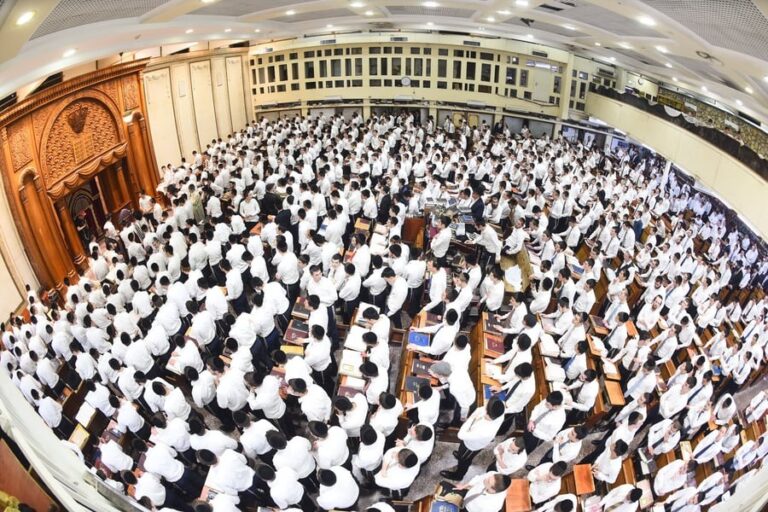by Rabbi Yair Hoffman for the Five Towns Jewish Times
Sal and Vinny, the barbers, have, uncharacteristically, been calling up the halacha hotlines across the country: Should we staff up for an onslaught on Friday or not?
[Actually, they probably have not called – but you get the picture].
On Sunday, most everyone can get a haircut. For those that keep the second Z’man, however, getting a haircut today, on Rosh Chodesh Sivan Erev Shabbos, is a machlokes – a big debate in halacha.
When Lag BaOmer falls on Sunday, it is kind of a bizayon – a slap in the face to the Shabbos to get a haircut for Lag BaOmer but not for Shabbos! Therefore, on the 31st of the Omer that falls on a Friday, it would be permitted to get a haircut.
But what about today?
The issue about not getting a haircut on Rosh Chodesh in general for those who follow the recommendations of Rav yehudah HaChassid – the Mishna Brurah had addressed that regarding Rosh Chodesh Iyar – that it would be permitted. But our question is can we apply the logic of haircut for Shabbos before Sunday Lag BaOmer to haircut before Shloshes yemei hagbalah of Shavuos?
Can we not apply the same logic here and allow a haircut for Shabbos on Rosh Chodesh Sivan when it falls on a Friday?
So the answer to this is that it is a Machlokes.
THOSE WHO PERMIT
The Pri Magadim in his Aishel Avrohom 493:5 goes with a minority opinion that when Rosh Chodesh Sivan falls on Sunday – one can get a haircut on that Sunday. Most people do not agree with this Pri Magadim – and the Mogain Avrohom clearly does not.
The Pri Magadim holds that since one could get a haircut on Sunday, then one can get it on Friday before Shabbos as well. Rav Shlomo Zalman Auerbach permitted it as did Rav Chaim Stein zt”l of Telze, and Rav Sraya Duvlitzky (Zeh HaShulchan Vol. I #493). Rav Gavriel Zinner in his Nitei Gavriel also rules permissively.
THOSE WHO FORBID
Rav Elyashiv zt”l is quoted as forbidding it (See Bain Pesach L’Shavuos p. 252) by his son-in-law Rav Yitzchok Zilberstein. Rav Moshe Feinstein is also quoted as forbidding it by his student Rav Elimelech Bluth Shlita in LeTorah v’Horaah (Vol. X p. 14).
The fact that the Mishna Brurah does not cite this example as he does for LaG Ba’Omer is indicative that he did not hold of applying the heter here.
The rationale for differentiating between the Shloshes yemei hagballah and Lag BaOmer is fascinating. It is only a slap in the face to Shabbos when we would get a haircut on Lag BaOmer, a special day. However, here, there is no slap in the face to Shabbos if the period of mourning is just ending – so there would be no heter to do so early.
CONCLUSION
There are choshuva Poskim who have suggested that this is not a question of being lenient or stringent in a minhag, but rather, on the opposite end, it is being lenient or stringent in Kavod Shabbos. They suggest that one can rely on the lenient Poskim to get a haircut before Shabbos. Nevertheless, we have the silence of the Mishna Brurah, the opinion of Rav Elyashiv zt”l, and also the quoted opinion of Rav Moshe. It is difficult to discount all three of them together. So in conclusion, ask your Rav or Posaik, but certainly one should not criticize those that get the haircut – especially if they are doing so on account of Kavod Shabbos.
Aside from the halacha about haircuts, we must keep in mind that there are three aspects to Sefirah:
1. It was the time that we transformed as a nation from a lowly spiritual state to our highest point of spirituality ever.
2. On the 16th of Nissan, a measure of the newly grown barley crop was brought to Hashem as an offering in the Beis HaMikdash. The amount of the offering was called an “omer,” which was one-tenth of an eifah. An eifah is the volume of 432 chicken eggs. So the Korban Omer is the volume of 43.2 eggs.
3. It is a sad period during which the 24,000 students of the great sage Rabbi Akiva died tragically.
The meforshim (see Rashash Siddur p. 1070) have explained that the first two aspects are tied to each other. The Korban Omer is made of barley, generally the feed of animals. On Shavuos we bring the Shtei HaLechem, food that is the exclusive domain of man. Thus the two offerings represent the transformation from a low spiritual state to a high one. Others have further pointed out that the third aspect also ties into the first two, in that the students of Rabbi Akiva, unfortunately, did not entirely fathom the full depth of the lesson of the spiritual apogee that the Shtei HaLechem offering represents.
The Rambam writes that it is a positive mitzvah of the Torah to count the Omer, as it states (Vayikra 23:15), “And you shall count for yourselves mi’macharas haShabbos.” The word “haShabbos” means after the yom tov—Pesach. The Rambam (Hilchos Temidim uMusafim 7:22) is of the opinion that at this time, even though we are in Galus and we do not have the Beis HaMikdash, the mitzvah still retains its biblical status.
Most other poskim (see Beis Yoseph O.C. 489), however, believe that the mitzvah is now only miDerabannan. The Ran, the Rosh, and Tosfos hold that since we no longer have the Beis HaMikdash, the mitzvah is only of rabbinic origin. The Mishnah Berurah rules like this latter opinion. However, the Rema writes that we must be concerned for the opinion that it is biblical, and that is why we are stringent in regard to these laws.
Period Of Transformation
During this period, with Hashem’s help, the Jewish nation transformed itself from the second-lowest level of impurity into becoming the Dor Deah, the generation of knowledge. In short, they catapulted themselves into becoming the greatest generation that ever lived.
The Zohar teaches us that on account of this transformation of the nation of Israel, the days themselves were imbued with special qualities and capabilities. How can we take advantage of them?
Our general tools of becoming close to Hashem throughout the year involve the areas of Torah, avodah, and chesed. This is through developing our connection to Hashem through studying His Torah, in our davening, and through emulating Him with acts of chesed. The spiritual “high” we feel after performing a genuine act of chesed, such as engaging in hachnasas kallah, is, in actuality, part of the journey of Dveikus Bashem—connecting and cleaving to Hashem.
During the time of Sefirah, we include an additional set of tools. The brother-in-law of Rav Shlomo Alkabetz was Rav Moshe Cordovera, zt’l, or the RaMaK. He lived in Tsfat in the 1500s. In the RaMaK’s Galus HaShechinah (p. 116 Yudaikin Edition) we find how these tools may be used:
Each of the seven weeks of the Omer represents one of the seven attributes of Hashem. Each day in the week also has the qualities of the seven attributes of Hashem as well.
The first week represents the attribute of Chesed, or lovingkindness.
The second week represents the attribute of Gevurah, or strength. Thus, the first day of the first week represents the concept or notion of chesed within the concept of chesed. The second day represents the idea of strength within chesed. Rather than to be ignored, this should be viewed as a rung of spirituality that one can ascend in one’s own personal growth.
The third week represents the attribute of Tiferes, or glory.
Then comes Netzach, consistency.
Hod represents beauty.
Yesod represents fundamentals.
The last week represents the attribute of Malchus—regality.
The combination of each of these attributes, wherein the attribute of the day is an element of the attribute of the week, serves to catapult our personal growth and development in emulating Hashem and developing our Dveikus toward Him. Thus, on the eighth day of the Omer, according to the RaMaK, we should focus on achieving the strength of chesed (gevurah sh’bechesed).
Increasing Our Sense
Of Appreciation
The Midrash further explains that the Torah gave us this mitzvah of bringing the Korban Omer on the 16th of Nissan in order to remind ourselves of the Omer of manna that we received from Hashem—each day we were in the wilderness. This element of the Sefiras HaOmer therefore serves to increase our hakaras ha’tov to Hashem for sustaining us in the wilderness as He made us into His Torah Nation. It also serves as a reminder that Hashem will always love us and watch out for us.
The author can be reached at [email protected]











